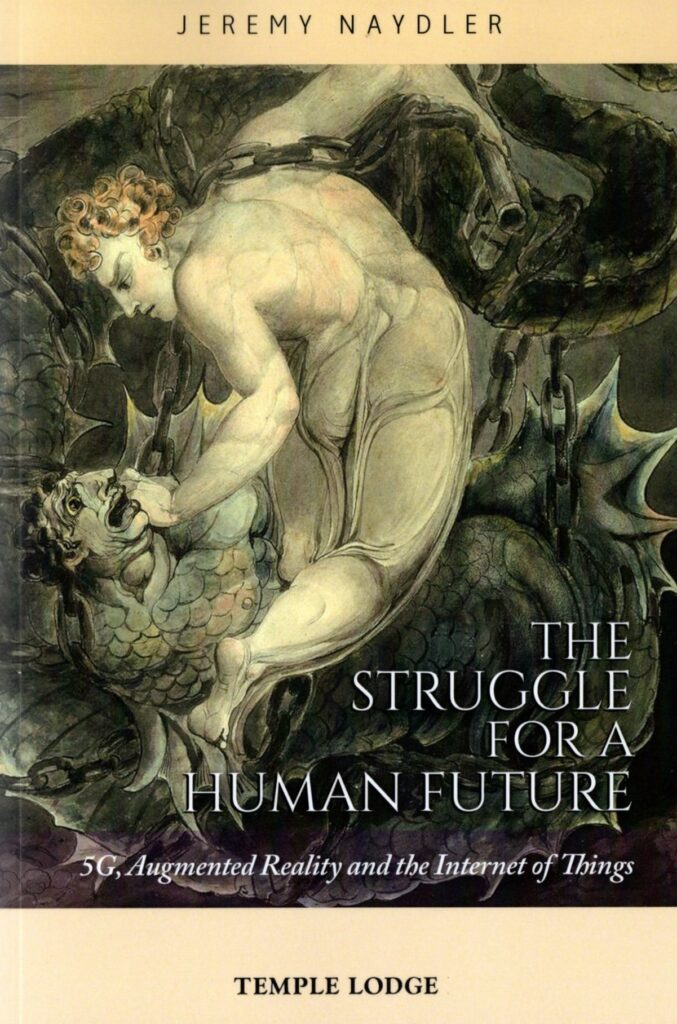The Struggle for a Human Future (Book Review)
5G, Augmented Reality and the Internet of Things
by Jeremy Naydler
Temple Lodge Publications, 2020
Jeremy Naydler’s book, The Struggle for a Human Future – 5G, Augmented Reality and the Internet of Things, is a very approachable book in terms of its presentation of the technology content. Only 105 pages of text, it is less daunting than Naydler’s comprehensive, 2018 book, In the Shadow of the Machine, The Prehistory of the Computer and the Evolution of Consciousness. In this new book, he brings us up to the present moment and helps us to see the future that is envisioned by the technocrats of the world, who believe that – no matter what the question – the answer is “technology”.
Having begun the book with discussion of “four shadow aspects of computer technology…addiction psychic fragmentation, abandonment of the real for the virtual and drift towards becoming cyborg”, the reader is then treated to a chapter on the metaphysical quest of humanity – which Naydler presents in the language of myth as a search “for the pearl”. He weaves his tale, going between ancient imagery of Kali Yuga, “the rapture” as conceived by some evangelical sects, and a science-based version illustrated “in the image of the astronaut, who has escaped gravity and floats freely above the earth”. This last he describes as the “new technological shaman, who enacts the collective dream of disincarnation and abandonment of the Earth.”
I asked a young friend what he thought about some of the things I was reading, including this quote from the misanthropic Ray Kurzweil. It succinctly expresses the dream world of those true believers in technocracy:
“…the culmination of the merger of our biological thinking and existence with the technology, resulting in a world that is still human but that transcends our biological roots. There will be no distinction, post-Singularity, between human and machine or between physical and virtual reality.”
My friend’s answer was this:
“As for the Kurzweil quote – there is a growth in what is considered virtual reality. On one side, there is being consumed by the virtual, which is scary, but I think it doesn’t happen as often as what I will say next, which is having the virtual world play a more significant part in your life than it did before. I think we’re far away from there being no distinction between physical and virtual reality. Virtual reality depends on physical reality, but the same cannot be said the other way around. Additionally, I have been alive since 1998, so I don’t know how our relationship with technology was like in the 80s & 90s.”
Note that he does not deny the possibility of being “consumed by the virtual” but seems comfortable with the idea that it doesn’t happen “as often” as what he seems to see as almost inevitable: the “virtual world [will] play a more significant part in your life than it did before.”
And how will that happen? Jeremy Naydler gives us many insights to the ways this new “virtual reality” technology will enter our lives. For most people, it will begin with “Augmented Reality”. For example, in his chapter on Technology and the Soul, he tells us that “Because 5G promises to enable far greater amounts of data to be processed at much higher speeds, the world will become increasingly permeated with virtual content to be retrieved with Augmented Reality applications “[as examples of apps that “retrieve” virtual objects, he points to Google Skymap and Pokemon Go]. “This will provide a strong impetus for the replacement of portable computers like the smartphone, tablet and laptop with wearable devices” like smartglasses, headsets, and smartwatches. “The wearable computer” he tells us, “will not, however, be the endpoint. It should be seen as a step on the way to a biologically integrated computer. The more we identify ourselves as ‘digital citizens’ living in a dual world in which virtual and real intermingle, the more we shall find ourselves channeled towards biological integration of computer technology. Preparations for this have long been underway. [As a kind of cross-over device], the so-called ‘bionic contact lens’, for example, was first developed at the University of Washington in 2008. It has an imprinted electronic circuit only a few nanometres thick, and is combined with microscopic light-emitting diodes. Because these components are so small, they do not obstruct a person’s view, but they do allow virtual displays to be projected in front of the eye, which only the wearer of the lens would perceive.” By 2016, these lenses were able to connect to a local device that gave them access to the Internet.
Among many thoughts this provokes is that it would appear to make examinations hard to proctor. Will there be electronic-implant-detection devices when pilots take their competency exams? Or will those jobs be among the first to be supplanted by robots?
Clearly, the world is going to become a very different place with devices that can be worn. What will it be like when they are implanted? Naydler discusses implications, saying: “What we are considering here is the augmentation of the powers of the human mind, but without any parallel ethical development of the human being. From a traditional religious standpoint, or equally from a modern esoteric standpoint, any increase in human mental capacities should only be sought in conjunction with the transformation of one’s shadow….Brain-machine interface technology, which will incorporate neural Internet connections, contains the inherent risk of artificially endowing human beings with abilities akin to clairvoyance, telepathic communication and enhanced powers of memory, without any accompanying moral development.” And he sees such technological enhancement as “an invitation to the inhuman to take up residence within the soul.”
Naydler guides us through a thought process and points to “the fact that current technological developments are not taking place in an ideological vacuum, but within a highly materialistic philosophical matrix, which is unable to conceive of a deeper level of thinking than that which solves problems through computational power alone [my emphasis]. This is in the tradition of Bacon, Hobbes, Descartes and Leibniz, whose mission it was to replace spiritual contemplation with calculative thinking as the paradigm for gaining knowledge. The history of modern computer technology has its origins in the mechanistic philosophy formulated in the seventeenth century by these thinkers. Along with the thoroughly materialistic assumptions of this stream of philosophy, this type of thinking continues to underpin the research that is conducted today and the long-term goals that are set for future innovations. No matter if many of those who use these technologies have a developed inner spiritual life, and would be the last to condone the materialistic worldview, the technologies themselves are not philosophically neutral. Computer technology as such is an embodiment of reductionist thinking.”
After an informative chapter outlining the history of microwaves, the regulation or lack thereof in the U.K. and the dangers of 5G which he calls the “multiple assault”, many readers will be grateful for Naydler’s final chapter titled: “Bringing Light to the World: Our Deepest Human Vocation.” In this chapter, he outlines Rudolf Steiner’s explanation of the relationship between light and thought, and he proposes three steps to build up “our relationship with the light as a spiritual foundation of our response to the technological challenges we face.”
This book is informative, thought provoking and a valuable offering “to counterbalance the negative forces that today assail humanity and menace the living Earth.”
The Struggle for a Human Future
Temple Lodge Publications, 2020
$19.00 at Rudolf Steiner Bookstore

Jeremy Naydler, Ph.D., holds a doctorate in theology and religious studies, and is a philosopher, cultural historian and gardener who lives and works in Oxford, England. He has long been interested in the history of consciousness and sees the study of past cultures – which were more open to the world of spirit than our own, predominantly secular, culture – as relevant both to understanding our situation today and to finding pathways into the future. His longstanding concern about the impact of electronic technologies on our inner life and on our relationship to nature has found expression in his book In the Shadow of the Machine (Temple Lodge 2018) and in numerous articles contributed to magazines such as New View, Self and Society and Resurgence. Jeremy Naydler has published eight books in all, going back to his first in 1996, Goethe on Science.




Responses